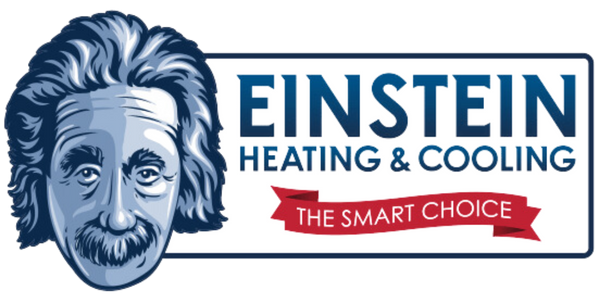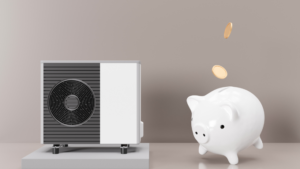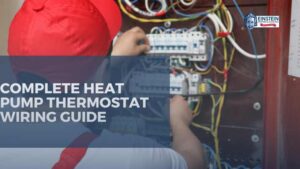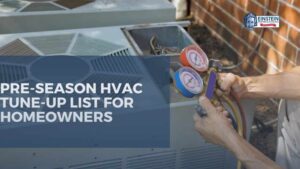When the cold of winter sets in, your HVAC (Heating, Ventilation, and Air Conditioning) system becomes vital for your home’s comfort. This comprehensive guide explores the key aspects of HVAC emergency heat, including how it works, when to use it, and factors affecting the efficiency of one’s HVAC unit. We’ve also included helpful tips to help you navigate through chilly emergencies.
Understanding Emergency Heat Mode
Definition and Functionality
When it comes to navigating the intricacies of your HVAC (Heating, Ventilation, and Air Conditioning) system, a fundamental aspect to grasp is the concept of emergency heat mode. Unlike the primary heating source, emergency heat operates as a safeguard, ready to step in during challenging circumstances.
Symptoms of a System in Emergency Heat Mode:
- The most apparent sign is often the activation of electric resistance heating elements when the primary heat source faces challenges.
- In this mode, your HVAC system bypasses the conventional heat pump and draws upon electric resistance heating to sustain indoor warmth.
What Is HVAC Emergency Heat Then?
Emergency heat is essentially a secondary or auxiliary heating mode designed to ensure your comfort when the primary heating system encounters difficulties. This mode is particularly crucial during severe cold spells or when the primary heating components are in need of repair.
How Does Emergency Heat Work?
Electric resistance heating plays a pivotal role in the functioning of emergency heat. Unlike the primary heat source, which may rely on a heat pump or furnace, emergency heat utilizes dedicated electric heating elements. These elements generate heat independently, providing an additional layer of warmth to your indoor spaces.
Differentiating Emergency Heat from Regular Heat
Understanding the distinction between emergency heat and the regular heating mode is essential for homeowners to make informed decisions regarding system operation.
Primary Heating vs. Emergency Heat:
Your HVAC system typically relies on a primary heating source, which may include a heat pump or furnace. This primary heat source is the go-to for everyday heating needs. However, when this primary system encounters issues, emergency heat steps in to maintain the desired temperature. While emergency heat is a reliable backup, it is important to note that it is less energy-efficient compared to the primary heating mode. The use of electric resistance heating elements consumes more energy, making it advisable to use emergency heat sparingly to prevent unnecessary spikes in energy consumption.
When to Activate Emergency Heat Mode
Understanding when to activate emergency heat is crucial for optimizing its effectiveness and preventing unnecessary strain on the system.
Subfreezing Temperatures:
Emergency heat is often automatically triggered when outside temperatures plummet below a certain threshold. During sub freezing conditions, the system may prioritize emergency heat to ensure your indoor spaces remain comfortably warm.
System Malfunctions:
In the event of primary heating system malfunctions, homeowners may need to manually activate emergency heat. This manual intervention ensures that your HVAC system continues to provide heat even when the primary components are undergoing repairs.
How Homeowners Can Leverage Emergency Heat
Educating homeowners on how to make the most of emergency heat is a crucial aspect of ensuring optimal system performance.
Temperature Settings:
Homeowners should be mindful of their thermostat settings, avoiding unnecessary adjustments that could trigger the activation of emergency heat. Consistent temperature settings contribute to efficient system operation.
Monitoring Thermostat Indicators:
Familiarizing yourself with the indicators on your thermostat related to emergency heat activation is essential. Regular monitoring allows homeowners to stay informed about the system’s operation and address any issues promptly.
Potential Pitfalls and Misuse
While emergency heat is a valuable feature, its misuse can lead to increased energy consumption and potential system damage.
Over-reliance on Emergency Heat:
Using emergency heat unnecessarily, especially in milder weather conditions, can lead to higher energy bills. Homeowners should be aware of when it is appropriate to activate emergency heat to avoid unnecessary energy consumption.
Lack of Maintenance:
Neglecting regular maintenance can also impact the efficiency of emergency heat. Homeowners should adhere to scheduled preventive maintenance practices to ensure all components, including those related to emergency heat, are in optimal condition.
In essence, comprehending the nuances of emergency heat mode equips homeowners with the knowledge needed to make informed decisions about their HVAC system. There are many emergency heating solutions you can do if ever your HVAC unit goes off suddenly. That’s why it’s also important that homeowners know which specific factors can influence the performance of the HVAC’s emergency heating.
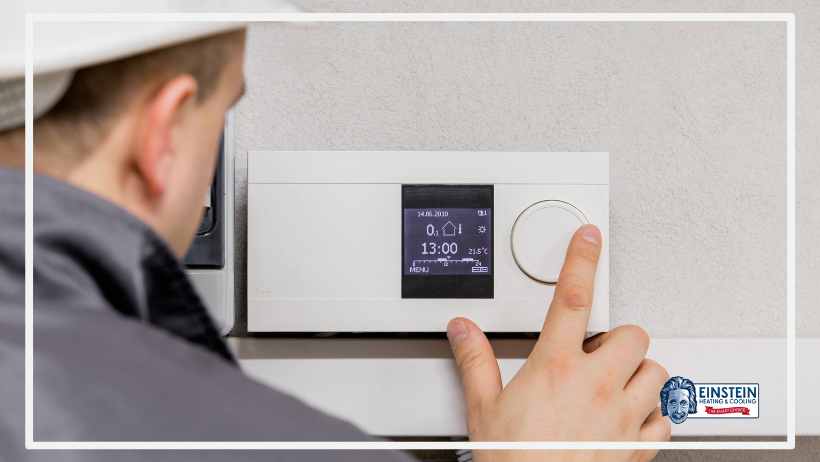
Factors Influencing HVAC Emergency Heat Performance
System Age and Condition
Older Systems
- Aging HVAC systems may struggle to efficiently execute emergency heat functions.
- Regular maintenance becomes a crucial ally in mitigating performance issues related to aging systems.
Well-Maintained Systems
- Before homeowners search up “HVAC emergency repair in Bend,” one must make sure of the basics of HVAC maintenance. Routine maintenance rituals ensure all components, including emergency heat elements, operate optimally.
- Proactive upkeep enhances the reliability of emergency heat.
Temperature Extremes and Load Demands
Extreme Cold Conditions
- In frigid temperatures, the HVAC system may increasingly lean on emergency heat to fulfill heightened heating demands.
- Consulting the manufacturer’s guidelines aids in understanding recommended temperature thresholds for efficient emergency heat usage.
System Load Demands
- High-demand periods, such as extremely cold days, might prompt the system to shift to emergency heat to meet heightened heating requirements.
- Anticipating and preparing for peak demand periods is pivotal.
Thermostat Settings and Programming
Proper Thermostat Programming
- Skillful thermostat programming optimizes the use of emergency heat during extreme conditions.
- Avoid frequent temperature adjustments, as they may trigger unnecessary emergency heat activation.
Understanding Thermostat Indicators
- Familiarizing yourself with your thermostat’s emergency heat indicators is crucial as HVAC repair in Oregon can be costly if done incorrectly.
- Regularly monitor thermostat settings to ensure they align with optimal emergency heat performance.
Electrical Components and Wiring
Inspecting Electrical Connections
- Regularly inspecting and tightening electrical connections is a preventative measure against disruptions in emergency heat operations.
- Faulty wiring can be a culprit behind emergency heat malfunctions and should be promptly addressed.
Compatibility with Emergency Heat Components
- Ensuring compatibility among all components related to emergency heat, including wiring and controls, is paramount.
- Periodic checks guarantee that all elements work in harmony.
Insulation and Home Efficiency
Proper Insulation
- Adequate home insulation lightens the load on your HVAC system, reducing the necessity for emergency heat.
- Identify and seal gaps, insulate windows, and reinforce doors to fortify against heat loss.
Energy-Efficient Windows and Doors
- Upgrading to energy-efficient windows and doors is a strategic move to minimize heat loss and improve overall system efficiency.
- Invest in quality materials to enhance insulation.
User Awareness and Training
Educating Homeowners
- Homeowners should be well-versed in the proper use of emergency heat to prevent misuse.
- Understanding the system’s capabilities empowers homeowners to contribute to effective and efficient operation.
Professional Training for Technicians
- HVAC technicians must undergo specialized training to diagnose and address emergency heat-related issues.
- Continuous education ensures technicians are equipped to handle emergency heat situations adeptly.
If your HVAC unit is still encountering various problems, it is best to contact a skilled technician to diagnose the issues.
5 Signs It’s Time to Seek HVAC Emergency Service
1. Unusual Heating System Behavior
Inconsistent Heating Levels
- Symptoms:
- Uneven distribution of heat across different rooms.
- Some areas are excessively warm, while others remain chilly.
- Reasoning:
- Malfunctioning components or improper heat distribution can trigger uneven heating.
- Emergency heat service may be required to identify and address the root cause.
Frequent Cycling On and Off
- Symptoms:
- The HVAC system turns on and off more frequently than usual.
- Short cycles without effectively reaching the set temperature.
- Reasoning:
- Issues with the thermostat, electrical components, or system settings may lead to frequent cycling.
- Emergency heat service can diagnose the problem and restore proper operation.
2. Strange Noises and Odors
Unusual Sounds During Operation
- Symptoms:
- Grinding, squealing, or banging noises when the HVAC system is running.
- Sounds that deviate from the normal hum or airflow.
- Reasoning:
- Mechanical issues, worn-out components, or loose parts may generate unusual sounds.
- Immediate HVAC repair in Bend can prevent further damage and restore quiet operation.
Foul Odors
- Symptoms:
- Unpleasant odors emanating from vents when the heating system is in operation.
- Burning or musty smells that persist over time.
- Reasoning:
- Accumulated dust, mold growth, or overheating components can cause odors.
- HVAC emergency heat service can address the source of the smell and ensure indoor air quality.
3. Reduced Heating Efficiency
Gradual Decline in Heating Performance
- Symptoms:
- The HVAC system takes longer to reach the desired temperature.
- Reduced overall heating efficiency compared to previous performance.
- Reasoning:
- Aging components, wear and tear, or insufficient HVAC maintenance can lead to a decline in performance.
- Timely HVAC emergency heat service can restore the system to optimal efficiency.
Increased Energy Bills
- Symptoms:
- Noticeable spikes in energy bills without a corresponding increase in heating usage.
- Higher-than-expected energy consumption during normal heating operations.
- Reasoning:
- A decline in system efficiency can result in increased energy consumption.
- HVAC emergency heat service can identify and rectify issues, leading to energy savings.
4. System Error Messages or Malfunctions
Thermostat Malfunctions
- Symptoms:
- Unresponsive thermostat or erratic temperature readings.
- Inability to set or maintain the desired temperature.
- Reasoning:
- Faulty thermostat wiring, sensor issues, or internal malfunctions can disrupt system communication.
- HVAC emergency repair can also assess and diagnose thermostat-related problems.
System Lockouts or Error Codes
- Symptoms:
- The HVAC system displays error codes or repeatedly goes into lockout mode instead of hvac emergency heat mode.
- System shutdowns without apparent reasons.
- Reasoning:
- Malfunctions in various components, such as the heat pump or ignition system, can trigger error codes.
- HVAC emergency heat service is essential to identify and resolve the underlying issues.
5. Ice Buildup on the Heat Pump
Visible Ice Accumulation
- Symptoms:
- Ice buildup on the exterior unit of the heat pump during cold weather.
- Reduced heat pump efficiency or complete system failure.
- Reasoning:
- Cold weather conditions can cause moisture to freeze on the heat pump, hindering operation.
- Emergency heat service can address ice buildup and restore normal heat pump function.
Steam or Vapor Emanating from the Unit
- Symptoms:
- Visible steam or vapor rising from the heat pump during operation.
- The heat pump appears to be struggling or operating inefficiently.
- Reasoning:
- Excessive ice buildup can lead to the heat pump entering defrost mode frequently.
- HVAC emergency heat service can address defrost issues and prevent long-term damage.
As homeowners, it’s important that one also takes good care of the HVAC emergency heat system as this helps us prolong its life and peak performance.
4 Tips for Optimizing HVAC Emergency Heat Usage
1. Regular Maintenance Practices
Scheduled HVAC Inspections
- Regular professional inspections are instrumental in identifying and addressing potential issues affecting emergency heat.
- Incorporate emergency heat components into the standard inspection checklist.
Filter Replacements
- Replace air filters as recommended to maintain optimal airflow and prevent undue strain on the HVAC system.
- Clogged filters can impede emergency heat performance.
2. Temperature Management Strategies
Consistent Thermostat Settings
- Setting your thermostat to a consistent temperature minimizes the need for frequent emergency heat activation.
- Avoid abrupt temperature fluctuations to foster system stability.
Zoning Systems
- Implementing zoning systems directs heat precisely where needed, optimizing overall efficiency.
- Zoning minimizes reliance on emergency heat in unused or less frequented spaces.
3. Energy-Efficient Home Practices
Sealing Air Leaks
- Identifying and sealing air leaks is a fundamental step in preventing heat loss and easing the burden on emergency heat components.
- Prioritize sealing windows, doors, and other vulnerable areas.
Smart Thermostats
- Investing in smart thermostats with advanced features optimizes heating schedules and reduces overall energy consumption.
- Some smart thermostats adapt to user preferences, further refining energy-efficient practices.
4. Emergency Preparedness for Homeowners
Understanding Emergency Heat Controls
- Homeowners must grasp how to manually activate emergency heat in case of system malfunctions.
- Clear instructions in user manuals aid in timely and accurate responses.
Emergency Heat Usage Guidelines
- Homeowners need to be educated on the appropriate circumstances for using emergency heat and when to seek professional HVAC emergency assistance.
- Proactive measures can prevent emergency situations and ensure the system’s longevity.
While it’s a reliable solution to combat the freezing temperatures, it’s essential to exercise caution to ensure both the HVAC system’s longevity and your safety. By adhering to the safety precautions listed below, you can harness the benefits of HVAC emergency heat while safeguarding your system and maintaining a secure environment within your home.
HVAC Emergency Heat Safety Precautions
1. Understand Your HVAC System
Before delving into emergency heat usage, it’s imperative to comprehend the workings of your HVAC system. Familiarize yourself with the user manual and identify the emergency heat setting to get ready when HVAC unit is not working. This initial step lays the foundation for a safe and efficient experience with your heating system.
System Overview
- Take time to understand the different components of your HVAC system, including the emergency heat function.
User Manual
- Refer to the user manual for detailed instructions on how to operate and maintain the emergency heat setting.
2. Regular Maintenance Checks
Routine maintenance is the backbone of a well-functioning HVAC system. This applies even more so when it comes to emergency heat. Regular checks can prevent potential hazards and keep your system running smoothly.
Inspect Filters
- Ensure filters are clean and unclogged to maintain proper airflow and prevent overworking the emergency heat feature.
Professional Inspections
- Schedule annual inspections by HVAC professionals to identify and address any issues before they escalate.
3. Temperature Control
Effectively managing the temperature settings is pivotal for optimal performance and safety when using emergency heat.
Moderate Temperature
- Avoid excessively high temperatures; maintain a moderate setting to prevent overheating and potential damage to the system.
Gradual Adjustments
- Make gradual adjustments to the temperature rather than abrupt changes to reduce strain on the HVAC system.
4. Ventilation Awareness
Proper ventilation is crucial to prevent the buildup of harmful gases and ensure the safe operation of your emergency heat feature.
Adequate Ventilation
- Ensure that the area where your HVAC system is located has proper ventilation to disperse any emissions.
Carbon Monoxide Detectors
- Install carbon monoxide detectors near your HVAC system to promptly detect any potential leaks.
5. Power Source Checks
The power source for your HVAC system plays a pivotal role in its functionality. Regular checks are necessary to prevent electrical issues and ensure safe operation.
Power Supply
- Verify that the HVAC system is connected to a stable power supply to avoid electrical fluctuations.
Circuit Breaker Inspection
- Check the circuit breaker regularly to ensure it is in good condition and can handle the load during emergency heat operation.
6. Emergency Heat Usage Guidelines
Understanding when and how to use emergency heat is essential for both efficiency and safety.
Use in Extreme Cold
- Activate the emergency heat feature only during extremely cold conditions to avoid unnecessary strain on the system.
Monitor Usage
- Keep a close eye on the duration of emergency heat usage and turn it off once the desired temperature is reached.
In Conclusion
HVAC emergency heat serves as a valuable asset during cold weather emergencies. Understanding its functionality, optimizing system performance, and adopting energy-efficient practices are key to ensuring its effectiveness. Regular maintenance from professionals at Einstein Heating and Cooling, temperature management, energy-efficient home practices, and homeowner education are crucial elements in unlocking the full potential of HVAC emergency heat.
